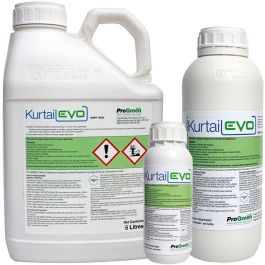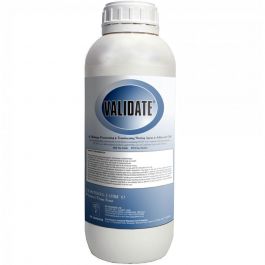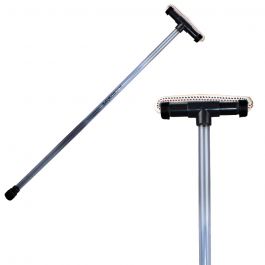How to Control Ivy

KEY FACTS
- Common Names: Common ivy, Common English ivy
- Scientific Name: Hedera Helix
- Timings: Seen all year round (evergreen plant)
- Areas Affected: Trees, overgrown borders, rough ground
PAGE CONTENTS:
- About Ivy
- How to Control Ivy
- How to Kill Ivy
- Equipment available
- When ivy is and isn’t a problem
- Training courses available
- FAQs

About Ivy
Ivy is a creeping/ climbing, evergreen plant, which has distinctive arrow-shaped leaves arising direct from the woody stem in its juvenile form and larger more rounded leaves once it reaches maturity.
Only the mature stems produce flowers in Oct/Nov. producing clusters of round green –black berries at the top of the stems.
It thrives in shady conditions and will act as a ground creeper, putting down adventitious roots as it spreads along the floor, or very often as a climber. It can also be found climbing up trees, fences, walls, and brickwork.
Many ornamental varieties have been bred in variegated forms but all can cause damage to buildings and fencing if left to grow unchecked.
How to Control Ivy?
Best products to spray on ivy:
At ProGreen the product we woud recommend for controlling ivy is Kurtail Evo and Kplus+. Below you will see an image showing the effect Kurtail Evo and Kplus+ has on ivy. Although Kurtail has the edge on other products, Gallup Biograde Amenity, Gallup HI-AKTIV, Roundup ProActive 360 and Roundup ProVantage 480g/L are also effective weedkillers for controlling ivy.
Ivy is resistant to most herbicides, due to the thick, waxy cuticle on the leaf. This makes it difficult to penetrate and liable to run-off by most herbicides so the addition of adjuvants, such as Validate (below) are essential to help the spray ‘stick’. The following options are available for using a non-residual, total weedkiller spray such as Roundup or Kurtail Evo. They produce excellent results and at peak treatment times in spring (usually May onwards) will produce results in 2-3 weeks.
How to kill Ivy with Roundup or Kurtail Evo:
Spray Application
- Best results for English Ivy control will come from a spray applied to young, soft leaf growth in the spring, usually May at the earliest. Over-wintered leaves have tough, thickened wax layers as they are hardened in the cold weather, which are more difficult to penetrate
-
Spring is the best time to apply an herbicide when 3 to 5 new leaves appear on the ivy vines. This new growth does not yet have the waxy leaf surface present on the older leaves, which allows for better penetration of herbicides. Alternatively, the English ivy can be mowed or cut back with a strimmer or brush cutter. When new growth appears, herbicides can be sprayed
-
If treating in late summer/ autumn cut back old growth as far as possible and wait for new leaves to emerge
-
Apply the highest rate of Roundup Pro Active recommended. In a knapsack this rate is 50 ml per litre of water sprayed to just before run-off
- Add Validate as an excellent adjuvant to stick to the ivy, improve the spray mixture and help the penetration of the waxy leaf surface
Directions:
-
Kurtail Evo: Mix 25ml in 1L water to spray and cover the leaf surfaces, enough to wet, but not dripping off.
-
Roundup & Validate: Apply the highest rate of Roundup Pro Active recommended, together with Validate to help it stick and penetrate the waxy leaf surface.
-
In a knapsack this rate is 50 ml Roundup Proactive and 2.6ml Validate per litre of water, sprayed to the point of run-off
No-Spray option:
- A weedwiper with 1 part Roundup ProActive to 2 parts water could also be used where decorative plants are growing intimately with the ivy
Monitor and retreat the sites as necessary over a period of three years
How to kill Ivy:
Cut Stump / Stem Injection Treatment
Where ivy is mature and growing up masonry or trees there may be a woody trunk which can be treated in the dormant season. This method is a very effective method of ivy control.
Timing
Ivy must be dormant, this usually occurs between November and February, although in some seasons and in the most northern parts of the country, this could extend until the end of March.
Cut Stump Method
- Chop the woody ivy stem at approx. 10-20cm above ground level. Clear at least 30cm of stem above it
- Rate: 20% solution of Roundup ProActive (ie, 4 parts water: 1 part Roundup)
- Method: application must be made to a fresh cut so that uptake into the phloem is maximised
Use a paintbrush and apply immediately after cutting. (Uptake is almost immediate from a fresh cut and will be rainfast within 10 minutes. Application to a cut that has partially sealed means absorption is slow and rain within 6 hours will wash some of the product off).
Cut Stump Method #2
Use Ecoplug Max as a safe, clean alternative to liquids on woody ivy stems
- Ecoplugs contain granulated glyphosate that dissolves in contact with the tree sap and is carried to the growing points in the stump roots
- Use a drill & Ecoplug drill bit to create a hole (purpose built drillbits use depth gauges) around the outer edge of the (freshly cut) tree stump face or into the sides of the stump.
- Knock in the Ecoplug with a hammer – ensuring the top edge is flush with the stump – this ensures it cannot be removed.
Chemical Thinning
- Rate: 2 mls of neat Roundup ProActive for each 10cm diameter of the stem.
- Method: neat weedkiller is introduced straight into the phloem through a hatchet cut into the bark of the ivy leaving the plant in tact.
A spot gun with a solid stream nozzle is recommended and it is advisable to make a second cut under the first to catch any surplus herbicide. Work out how many hatchet cuts are needed according to the diameter of the trunk and space them round the girth e.g. trunk of 20cm diameter requires 2 x 2mls cuts. Alternatively the concentrate can be introduced through an 8mm drill hole, about 40mm long, aimed slightly downwards and radially towards the centre of the stem.
Equipment Available for Ivy Control
The equipment we would suggest for use when controlling ivy is as follows:
- Knapsack Sprayer – for use when spraying glyphosate weed killer onto the ivy
- Weed Wiper – an alternative option to spraying. Allows for more precise application avoiding spray drift to affect plants you are wanting to keep
- Stem Injector – for use when using the chemical thinning method to kill ivy.
When Ivy is and isn’t a Problem
Ivy can be seen both as a valued plant and as a troublesome weed. Ivy has high value to wildlife offering birds and other woodland creatures a place to forage in the leaf litter during colder months. Alongside this the plant can also be a great late nectar source for many pollinating insects. Many also see the plant as a decorative feature that can cover an unsightly wall they are not too fond of.
On the flip side ivy can become a problem as it can become invasive very quickly. If left and not controlled it can creep into neighbouring properties, up your walls, onto roofs and even block up guttering. Ground cover ivy can also spread and smother other plants blocking any chance of them from getting sunlight. Alongside all of this, ivy can be slightly poisonous causing animals and small children to vomit or develop a fever. The leaves can also cause contact dermatitis when touched.
Training Courses for Killing Ivy
At ProGreen we offer a variety of different courses. When it comes to controlling Ivy the best courses to look at would be PA1 safe use of pesticide training and PA6 safe use of hand-held applicators training. This will teach you how to safely handle professional grade pesticides and how to apply them using a knapsack sprayer. If you are looking into killing the ivy using the stem injection method, then our PA6ING handheld application using injection equipment will be for you.
FAQs
When should I control ivy?
Ivy should be controlled when the health of the trees it is covering is in decline and you want to maintain the stability of the trees.
Are home methods effective?
While home methods can be effective at controlling ivy, if you want to fully kill and remove the ivy then we recommend professional products.
Unsure of which application method is best for you? Call for FREE technical advice - 01778 394052

















